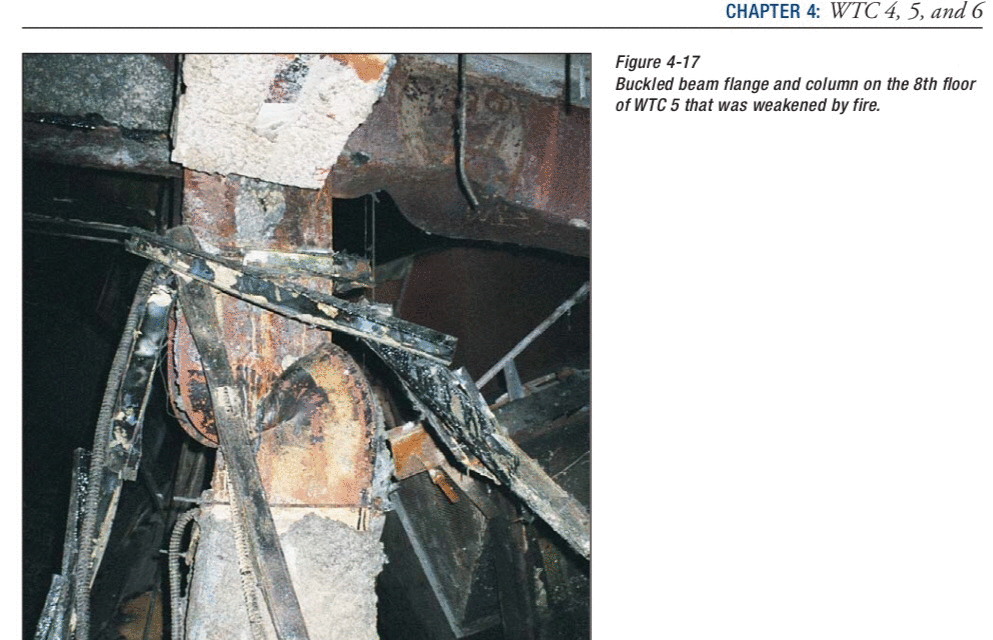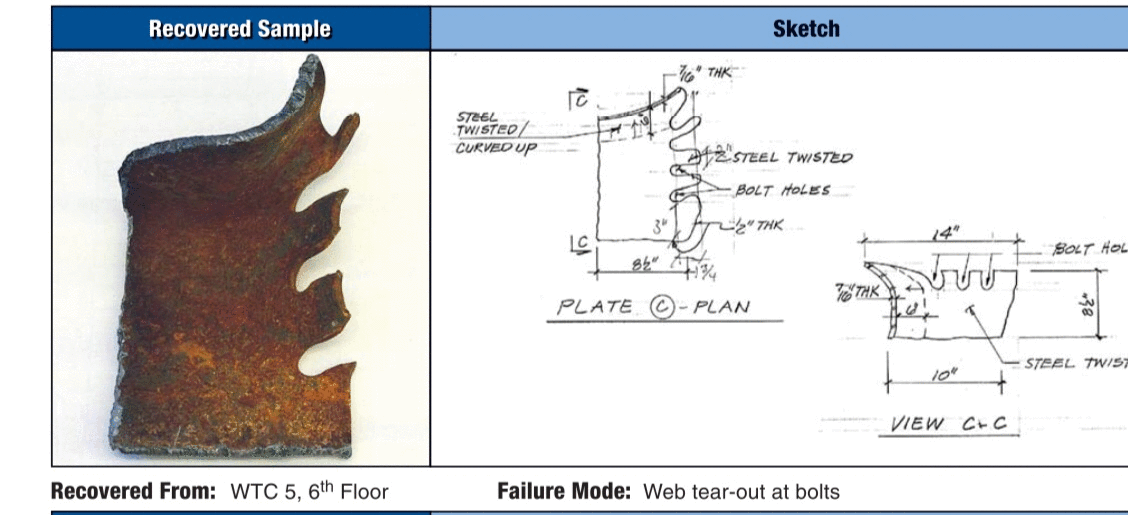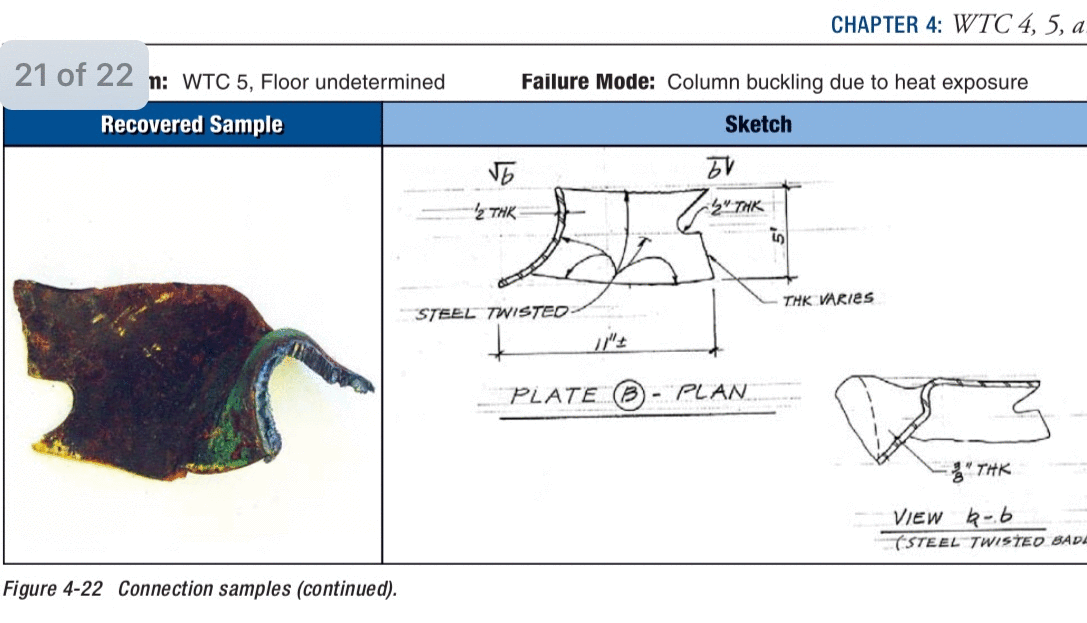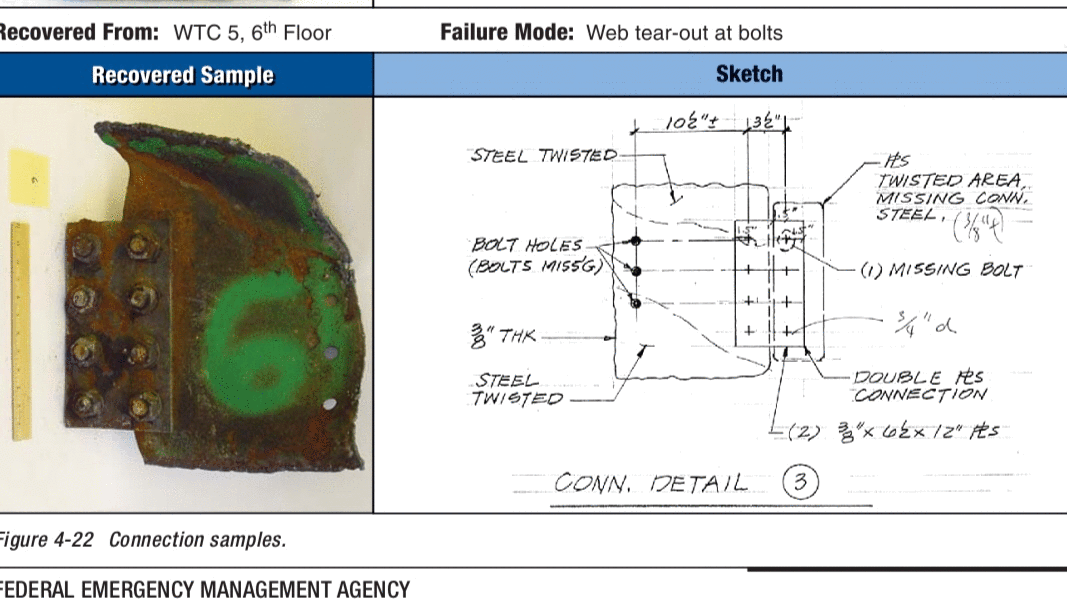It looks like you're using an Ad Blocker.
Please white-list or disable AboveTopSecret.com in your ad-blocking tool.
Thank you.
Some features of ATS will be disabled while you continue to use an ad-blocker.
share:
originally posted by: OtherSideOfTheCoin
originally posted by: surfer_soul
a reply to: neutronflux
You’re in denial, pure and simple. Move on with your life
Have you ever considered that you might be in denial, not making the accusation just asking the question. [/
Ive considered looking at all possibilities and of all the wacky theories the official story which I believed for a while happens to be the hardest to swallow.
I DONT BUY IT
Ive considered looking at all possibilities and of all the wacky theories the official story which I believed for a while happens to be the hardest to swallow.
I DONT BUY IT
Would you care to fix the formatting to clarify your response?
WTC 5 shows the WTC buildings were susceptible to fire related collapse.
By the way. The bowing and buckling of WTC columns is captured on video leadings to collapse initiation.
Now, can you produce video of columns being visibly cut?
So, which is more credible than fire related collapse?
Fizzle no flash bombs?
Thermite paint or ceiling tiles?
Holograms with missiles and or lasers?
Doctor Wood’s Dustification?
Nukes?
edit on 5-8-2019 by neutronflux because: Fix formatting
edit on 5-8-2019 by neutronflux because: Fixed
more
edit on 5-8-2019 by neutronflux because: Fixed more
Funny how so many conspiracy believers forget that WTC7 was built over top of a electrical substation.
It seems like they used so many susceptible construction methods that we wouldn't consider these days.
It seems like they used so many susceptible construction methods that we wouldn't consider these days.
originally posted by: samkent
Funny how so many conspiracy believers forget that WTC7 was built over top of a electrical substation.
It seems like they used so many susceptible construction methods that we wouldn't consider these days.
You have to wonder if that is why NIST published the WTC reports in the way they did. It’s like they didn’t want to dig too deep into the actual methods of construction, contractors, mob connections, what materials were actually supplied. It’s pure innuendo, but I think that is the real cover up. From the WTC Fire insulation, to the welds of vertical columns.
But the towers did survive long enough where most people that had the means could escape.
originally posted by: samkent
Funny how so many conspiracy believers forget that WTC7 was built over top of a electrical substation.
It seems like they used so many susceptible construction methods that we wouldn't consider these days.
Forget? They don't ever even think to investigate details like that. Let's face it, a lot of them believe nothing hit building 7!
originally posted by: samkent
Funny how so many conspiracy believers forget that WTC7 was built over top of a electrical substation.
It seems like they used so many susceptible construction methods that we wouldn't consider these days.
Dude I don't think most of them actually know that.
originally posted by: firerescue
a reply to: Bigburgh
After the water mains were cut by the collapse of the Twin Towers the FDNY laid in a supply line from fire boats in the Hudson River several blocks away
In WTC 7 the FDNY crews sent to search the building in wake of Twin Towers collapse found significant structural damage
starting with a 20 story gash in the south façade (side which faced WTC towers), elevator cars ejected from shafts, stairways blocked with debris
Also found that the internal standpipes were inoperable, so even if could get water to WTC 7 the internal plumbing system was not working , so was no way to transport water to where if was needed
Without water and working elevator system no FDNY commander is going to put men in that building - would be too
easy to become trapped
As WTC 7 was abandoned (I know several people who worked in building, it was evacuated at 930 before the Towers collapse) , with fire breaking out on several fires, the order was given for the FDNY to clear the building
Mid afternoon a bulge 3 stories high was seen forming in the SW corner of WYC 7 - this lead to collapse zone being
formed around WTC 7 and area cleared at about 2 )M
WTC was left to burn until collapsed at 520 PM
And don’t forget the 343 firefighters lost on 9/11, and the equipment made useless.
A total of 412 first responders and emergency workers were lost on 9/11.
originally posted by: neutronflux
The context of my argument.
Crucially, a team of engineers at the University of Alaska concluded this week, after two years of forensic research, that fire could not have caused the collapse of WTC7.
www.dailymail.co.uk...
So, the WTC 7 collapse could not have been from fire?
One, how do you prove a negative?
Two, would not the fire related damage of WTC 5 prove fire related collapse of WTC 7 was very possible. Especially if WTC 7 had longer floor spans, and taking in account the uncommon floor connection angles of WTC 7.
WTC 5 damage
4 WTC 4, 5, and 6
www.fema.gov...
from the 5th floor and above. Some steel beams supporting the roof were deformed due to the heat, as illustrated in Figure 4-14, and some local buckling occurred as well. Roof tar entered the floor through the drains. There is no indication that this roof tar played a major role in the fires. One area below the roof at the 8th floor collapsed onto the 7th floor and then both onto the 6th, and so on, down to the 4th floor.
The structural damage due to the
fires closely resembled that commonly
observed in test assemblies exposed to
the ASTM E119 Standard Fire Test.
After testing, the deformed shapes of
beams, girders, and columns are similar
to the structural damage that occurred
in these buildings.
Damage from debris of WTC 1 and WTC 2
The debris from the towers caused damage to the outside wall steel framing of WTC 5, but this damage did not cause any additional collapse of the floors. In fact, the steel pipe façade supports (mullions) provided structural redundancy to the floor framing and redistributed some portion of the cantilevered floors to other levels.
www.fema.gov...
WTC 5 - Local Collapse Mechanisms
4.3.2 WTC 5 - Local Collapse Mechanisms
Two areas in WTC 5 experienced local collapse under an intact portion of the roof. Although there was debris impact near this area, the symmetrical nature of the collapse strongly suggests that the failures were due to the uncontrolled fires. This is supported by the observation that the columns in this area remained straight and freestanding (see Figure 4-18). This local collapse appeared to have begun at the field connection where beams were connected to shop-fabricated beam stubs and column assemblies as illustrated in Figures 4-19, 4-20, and 4-21.
The structural collapse appeared to be due to a combination of excessive shear loads on bolted connections and unanticipated tensile forces resulting from catenary sagging of the beams. The existence of high shear loads, likely due to collapsing floor loads from above, was evident in many of the column-tree.
Snip
beam stub cantilevers that formed diagonal tension field mechanisms in the cantilever webs and plastic moments at the column, as seen in Figure 4-18.
It is apparent that fire weakened the steel, contributing to the large shear-induced deformations observed in several of the cantilever beams. The shear failures observed at connection ends in several of the beam web samples shown in Figure 4-18 are indicative of the tensile forces that developed. The end bearing resistance of the beam web was found to be less than the double shear strength of the high-strength bolts, based on the analysis presented in Appendix B.
Steel framing connection samples were recovered from floors 6, 7, and 8 of WTC 5 with the aid of the New York Department of Design and Construction (DDC) and are described in Figure 4-22.
www.fema.gov...
Starters one of the pictures is showing girders intact with sagging- how do you explain this? NIST claimed the inside of WTC7 was a hollow shell before the perimeter outside collapsed. The conclusion you make is wrong a partial collapse, is a sample of area damage. A full collapse is entire building collapsing and it's gone.
We have 9/11 videos and photographs showing WTC5 and the entire top section was ablaze.
Again it very suspicious a building with light fires was not saved on 9/11. They called off all fire efforts to save WTC7 at 11 am or 12 pm not sure the time, yet was around then. So who made this call and this has to be investigated. If WTC7 was demolished and firemen were called off saving it, then someone in know made this decision!
edit on 5-8-2019 by Jesushere because: (no reason given)
a reply to: Jesushere
The fires in WTC 7 were heavy and wide spread. How do you have light fires if you don’t fight the fires for hours? The water supply was very limited, and over 340 firefighters were lost due to the towers, with equipment.

Yes, the floors pictured were near the roof. However you characterization of WTC 7 is wrong. The argument is the floor connections around floor 13 broke around column 79? The loss of lateral support from the floor connections lead to column 79 to buckle and initiate a progressive collapse. What if the failures were not near the roof like in WTC 5, but had 34 floors above them? With various forms of thermal stress applied.
And isn’t the major truth movement claim the floor connects in WTC 7 could not fail to leave column 79 with no lateral support? Yet the floor connections in WTC 5 failed in two to three different modes.
Again it very suspicious a building with light fires was not saved on 9/11.
The fires in WTC 7 were heavy and wide spread. How do you have light fires if you don’t fight the fires for hours? The water supply was very limited, and over 340 firefighters were lost due to the towers, with equipment.

Yes, the floors pictured were near the roof. However you characterization of WTC 7 is wrong. The argument is the floor connections around floor 13 broke around column 79? The loss of lateral support from the floor connections lead to column 79 to buckle and initiate a progressive collapse. What if the failures were not near the roof like in WTC 5, but had 34 floors above them? With various forms of thermal stress applied.
And isn’t the major truth movement claim the floor connects in WTC 7 could not fail to leave column 79 with no lateral support? Yet the floor connections in WTC 5 failed in two to three different modes.
edit on 5-8-2019 by neutronflux because: Added and fixed
originally posted by: neutronflux
a reply to: Jesushere
Again it very suspicious a building with light fires was not saved on 9/11.
The fires in WTC 7 were heavy and wide spread. How do you have light fires if you don’t fight the fires for hours? The water supply was very limited, and over 340 firefighters were lost due to the towers, with equipment.
Yes, the floors pictured were near the roof. However you characterization of WTC 7 is wrong. The argument is the floor connections around floor 13 broke around column 79? The loss of lateral support from the floor connections lead to column 79 to buckle and initiate a progressive collapse. What if the failures were not near the roof like in WTC 5, but had 34 floors above them? With various forms of thermal stress applied.
And isn’t the major truth movement claim the floor connects in WTC 7 could not fail to leave column 79 with no lateral support? Yet the floor connections in WTC 5 failed in two to three different modes.
What you saying there is untrue. We got pictures, one can see the fires were contained within the lower section portion of the building" Roughly around 14 floors had pockets of light small and medium-range fires. Fires like this can be easily suppressed with water and other fire suppressants. According to the official account, a decision was made and it can only come from superiors in crisis management to halt all fire activities to save this building. It very suspicious the decision was made early in the day, only 1 hour after the collapse of the Twin towers- the building was just left alone for up 5 to 6 hours, this still personally bugs me.
NIST probable theory was a single girder at column 79' floor 12 and 13 expanded due to fires and the girder slipped of its positioned seat and fell downwards " this they claim caused floors, above 13 and below 12 to fail with it. NIST then claims all the floors across the width of the building buckled and fell away too. Interesting theory till you examine the construction of building seven and you notice the girder is protected and can not move 360 degrees. The girder is welded with a web plate to stop it from moving side to side, plus the girder has multiple shear studs welded to the deck of the floor to hold everything in place. NIST ignored all this and basically left a girder unsupported in their local computer simulation and just forced it to collapse.
NIST refused to release their computer simulation data so people can't check their work and find errors. NIST even #ed up massively when they held a tech conference in Aug 2008 and they themselves when asked a question about freefall, said we found no evidence this occurred!
Six years and at this stage'- NIST missed an important feature of the actual collapse! And after realising the question was asked was, in fact, true- freefall had occurred, they rewrote a section of their report and released a revised edition of their final report on Nov 2008. In this report, they make the startling claim freefall was thought of all along and was never left out? NIST got away with it this, we should never forget what they said at their conference and only three months earlier were they personally ruled out freefall!
edit on 5-8-2019 by Jesushere because: (no reason given)
edit on 5-8-2019 by Jesushere because: (no reason
given)
edit on 5-8-2019 by Jesushere because: (no reason given)
a reply to: Jesushere
Do you know portions of lower WTC 5 were not consumed by fire. Anyway....
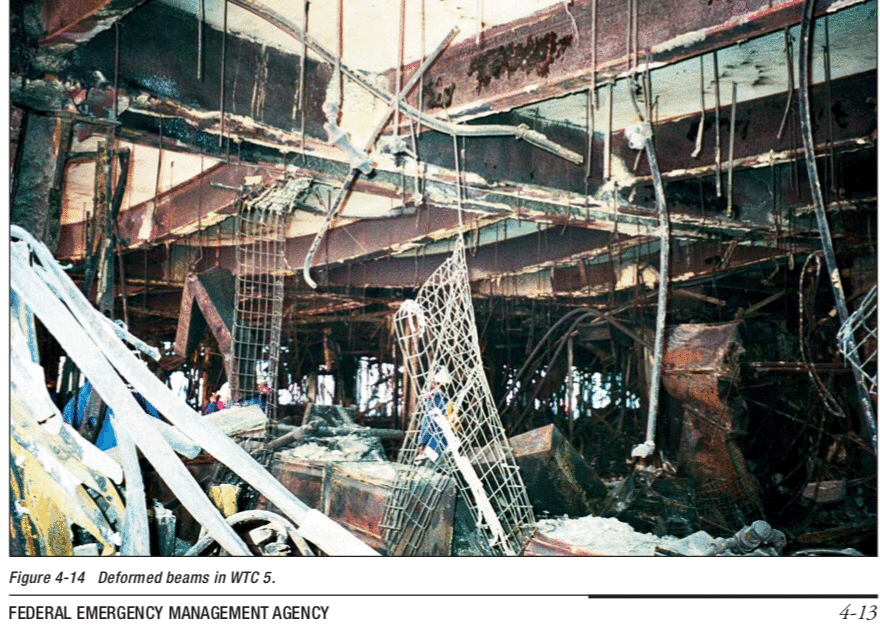
In fact, if you look closely in the picture above. You can see items not scorched. In fact, uneven heating can be more detrimental to a steel structure. Is that false.
WTC 5 does show fire related failures are possible in what was the WTC steel structures. Is that false?
If the fires were not fought, how were they “contained”
Below. Account of WTC fires.
Seems you are referring to a select few pictures, while ignoring all the WTC 7 photos/video, while ignoring accounts. While ignoring that uneven fires in fact might have made conditions worse.
Do you know portions of lower WTC 5 were not consumed by fire. Anyway....

In fact, if you look closely in the picture above. You can see items not scorched. In fact, uneven heating can be more detrimental to a steel structure. Is that false.
WTC 5 does show fire related failures are possible in what was the WTC steel structures. Is that false?
What you saying there is untrue. We got pictures, one can see the fires were contained within the lower section portion of the building" Roughly around 14 floors had pockets of light small and medium-range fires
If the fires were not fought, how were they “contained”
WTC 7 fires
www.911myths.com...
This is plainly a threat to the “limited fires” idea, as recognised here.
Firstly, we are told that there were fires on the floors 7, 8, 10, 11, 12, 19, 27 and 28, but the photo seems to have smoke pouring out of the windows on almost every floor.
Secondly, the corner offices (except for the 27th and 28th floors) show no indication of fire on the west face of the building, but these very same corner offices appear to belch smoke from their south face windows.
Thirdly, the north side of WTC 7 has few (if any) visible signs of fire at this time (for example, see Figure 5-20 below) so it seems quite impossible that the south side should be ablaze to the extent that the above photo would indicate.
www.wtc7.net...
So what does the writer do with this information? Change his mind and accept that maybe there were larger fires in WTC7, after all?
Below. Account of WTC fires.
sites.google.com...
FDNY Chief of Operations Daniel Nigro, "Report from the Chief of Department," Fire Engineering, 9/2002)
I do remember us being pulled off the pile. ...We were down by the pile to search or looking around. 7 World Trade Center was roaring. I remember being pulled off the pile like just before. It wasn't just before. It was probably an hour before 7 came down. –Firefighter Kevin Howe
Hayden: By now, this is going on into the afternoon, and we were concerned about additional collapse, not only of the Marriott, because there was a good portion of the Marriott still standing, but also we were pretty sure that 7 World Trade Center would collapse. Early on, we saw a bulge in the southwest corner between floors 10 and 13, and we had put a transit on that and we were pretty sure she was going to col-lapse. You actually could see there was a visible bulge, it ran up about three floors. It came down about 5 o’clock in the afternoon, but by about 2 o’clock in the afternoon we realized this thing was going to collapse.
Firehouse Magazine: Was there heavy fire in there right away?
Hayden: No, not right away, and that’s probably why it stood for so long because it took a while for that fire to develop. It was a heavy body of fire in there and then we didn’t make any attempt to fight it. That was just one of those wars we were just going to lose. We were concerned about the collapse of a 47-story building there. We were worried about additional collapse there of what was remaining standing of the towers and the Marriott, so we started pulling the people back after a couple of hours of surface removal and searches along the surface of the debris. We started to pull guys back because we were concerned for their safety.
Firehouse: Chief Nigro said they made a collapse zone and wanted everybody away from number 7— did you have to get all of those people out?
Hayden: Yeah, we had to pull everybody back. It was very difficult. We had to be very forceful in getting the guys out. They didn’t want to come out. There were guys going into areas that I wasn’t even really comfortable with, because of the possibility of secondary collapses. We didn’t know how stable any of this area was. We pulled everybody back probably by 3 or 3:30 in the afternoon. We said, this building is going to come down, get back. It came down about 5 o’clock or so, but we had everybody backed away by then. –Deputy Chief Peter Hayden
There was a big discussion going on at that point about pulling all of our units out of 7 World Trade Center. Chief Nigro didn't feel it was worth taking the slightest chance of somebody else getting injured. So at that point we made a decision to take all of our units out of 7 World Trade Center because there was a potential for collapse.
Q. It was on fire, correct, Captain?
A. Yes, it was on fire at that time. Then they said it suffered some form of structural damage. These things were going on at the same time. The fact that we thought we found Ganci and Feehan and his place at 7 World Trade Center. Made the decision to back everybody away, took all the units and moved them all the way back toward North End Avenue, which is as far I guess west as you could get on Vesey Street, to keep them out of the way. –Captain Ray Goldbach
So we go there and on the north and east side of 7 it didn’t look like there was any damage at all, but then you looked on the south side of 7 there had to be a hole 20 stories tall in the building, with fire on several floors. Debris was falling down on the building and it didn’t look good. But they had a hose line operating. Like I said, it was hitting the sidewalk across the street, but eventually they pulled back too. –Capt. Chris Boyle
Seems you are referring to a select few pictures, while ignoring all the WTC 7 photos/video, while ignoring accounts. While ignoring that uneven fires in fact might have made conditions worse.
edit on 5-8-2019 by neutronflux because: Added and fixed.
edit on 5-8-2019 by
neutronflux because: Fixed more
edit on 5-8-2019 by neutronflux because: Fixed more
a reply to: Jesushere
So? What sources of available water were not being utilized? After losing over 340 firefighters and equipment, where was the manpower and equipment to fight fires on “floors 7, 8, 10, 11, 12, 19, 27 and 28”
Yet, there are various modes of floor connection failures documented from WTC 5. How does welds and shear studs prevent failures from thermal stress? In fact, not being able to expand or contract are some of the worse conditions for straight runs of steel under thermal stress.
How does shear studs and welds prevent weakening of steel when heated? So? You don’t need fire insulation, you just need shear studs and welds. Well, that don’t make much sense.
You
Good thing there are at least two other studies besides the NIST study that shows the WTC 7 fire related failure was the most likely cause of the progressive collapse. One of those studies was submitted as a deposition to a court case.
According to the official account, a decision was made and it can only come from superiors in crisis management to halt all fire activities to save this building.
So? What sources of available water were not being utilized? After losing over 340 firefighters and equipment, where was the manpower and equipment to fight fires on “floors 7, 8, 10, 11, 12, 19, 27 and 28”
NIST then claims all the floors across the width of the building buckled and fell away too. Interesting theory till you examine the construction of building seven and you notice the girder is protected and can not move 360 degrees. The girder is welded with a web plate to stop it from moving side to side, plus the girder has multiple shear studs welded to the deck of the floor to hold everything in place
Yet, there are various modes of floor connection failures documented from WTC 5. How does welds and shear studs prevent failures from thermal stress? In fact, not being able to expand or contract are some of the worse conditions for straight runs of steel under thermal stress.
How does shear studs and welds prevent weakening of steel when heated? So? You don’t need fire insulation, you just need shear studs and welds. Well, that don’t make much sense.
You
Six years and at this stage'- NIST missed an important feature of the actual collapse!
Good thing there are at least two other studies besides the NIST study that shows the WTC 7 fire related failure was the most likely cause of the progressive collapse. One of those studies was submitted as a deposition to a court case.
edit on 5-8-2019 by neutronflux because: Added and
fixed
a reply to: Jesushere
Now. Do you agree the facade fell at the rate of free fall for a period. For the free fall of the facade to take place for the supposed 18 floors , then you agree the WTC 7 exterior columns had to buckle? Do you agree the WTC 7 exterior columns were right at the facade, and facade windows. From the WTC 7 windows, there is no flashing, sparking, no evidence of cutting charges cutting into the facade, and no evidence of explosions cutting exterior columns.
Now. Do you agree the facade fell at the rate of free fall for a period. For the free fall of the facade to take place for the supposed 18 floors , then you agree the WTC 7 exterior columns had to buckle? Do you agree the WTC 7 exterior columns were right at the facade, and facade windows. From the WTC 7 windows, there is no flashing, sparking, no evidence of cutting charges cutting into the facade, and no evidence of explosions cutting exterior columns.
edit on 5-8-2019 by neutronflux because: Added and fixed
a reply to: neutronflux
Light fires ?? FDNY called off ….??
The FDNY incident commanders ordered their men out of WTC 7 after receiving reports of heavy structural damage, spreading fires and lack of water and damage to interior standpipes
The building was cleared in early afternoon , a transit was set up to watch the building . By 230PM a large bulge was forming in the SW side of the building . The bulge was some 3 stories . It showed that the building was shifting and
becoming unstable
A collapse zone was established around WTC 7 at 3PM and the area was cleared of men and equipment
Reason WTC 7 was abandoned was it too dangerous for crews to enter especially with no water to fight the fires
Incident commanders were not going to risk further injury to their men for an empty building - WTC 7 had been cleared by 930 mam
I heard this from the onsite incident commanders in a seminar 5 months after 911 ………...
Again it very suspicious a building with light fires was not saved on 9/11. They called off all fire efforts to save WTC7 at 11 am or 12 pm not sure the time, yet was around then. So who made this call and this has to be investigated. If WTC7 was demolished and firemen were called off saving it, then someone in know made this decision!
Light fires ?? FDNY called off ….??
The FDNY incident commanders ordered their men out of WTC 7 after receiving reports of heavy structural damage, spreading fires and lack of water and damage to interior standpipes
The building was cleared in early afternoon , a transit was set up to watch the building . By 230PM a large bulge was forming in the SW side of the building . The bulge was some 3 stories . It showed that the building was shifting and
becoming unstable
A collapse zone was established around WTC 7 at 3PM and the area was cleared of men and equipment
Reason WTC 7 was abandoned was it too dangerous for crews to enter especially with no water to fight the fires
Incident commanders were not going to risk further injury to their men for an empty building - WTC 7 had been cleared by 930 mam
I heard this from the onsite incident commanders in a seminar 5 months after 911 ………...
originally posted by: muzzleflash
a reply to: neutronflux
WTC 7 experienced a fully symmetrical collapse.
The uniformity and well proportioned nature of this collapse makes no sense if we are to assume that a fire caused it.
How could the 'fire' have destabilized every part of the structure at once?
No it didn't want to explain this picture
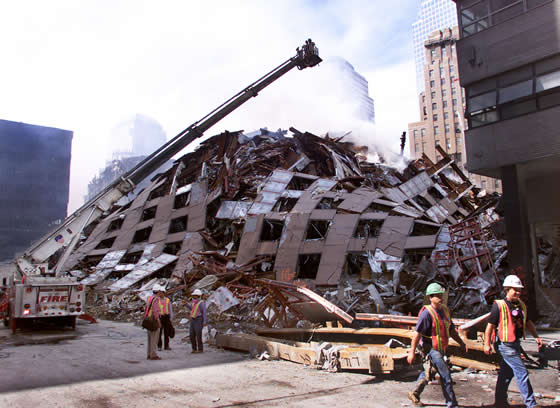
How can those panels be lying on top of the debris, from the direction you see the collpapse it looks like a vertical collapse but its not.
Other damage
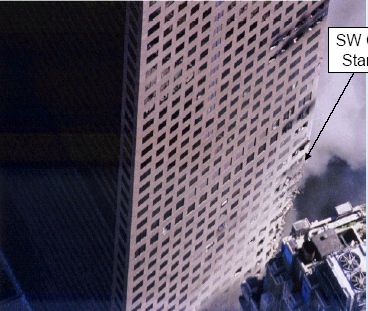
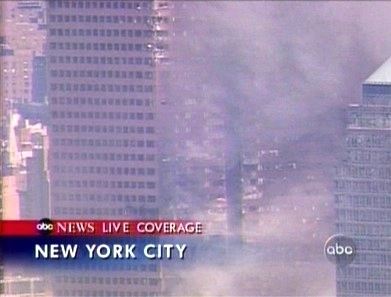
Fire, impact from North Tower collapse , structural damage and dynamic loads brought it down.
originally posted by: neutronflux
a reply to: Jesushere
Do you know portions of lower WTC 5 were not consumed by fire. Anyway....
In fact, if you look closely in the picture above. You can see items not scorched. In fact, uneven heating can be more detrimental to a steel structure. Is that false.
WTC 5 does show fire related failures are possible in what was the WTC steel structures. Is that false?
What you saying there is untrue. We got pictures, one can see the fires were contained within the lower section portion of the building" Roughly around 14 floors had pockets of light small and medium-range fires
If the fires were not fought, how were they “contained”
WTC 7 fires
www.911myths.com...
This is plainly a threat to the “limited fires” idea, as recognised here.
Firstly, we are told that there were fires on the floors 7, 8, 10, 11, 12, 19, 27 and 28, but the photo seems to have smoke pouring out of the windows on almost every floor.
Secondly, the corner offices (except for the 27th and 28th floors) show no indication of fire on the west face of the building, but these very same corner offices appear to belch smoke from their south face windows.
Thirdly, the north side of WTC 7 has few (if any) visible signs of fire at this time (for example, see Figure 5-20 below) so it seems quite impossible that the south side should be ablaze to the extent that the above photo would indicate.
www.wtc7.net...
So what does the writer do with this information? Change his mind and accept that maybe there were larger fires in WTC7, after all?
Below. Account of WTC fires.
sites.google.com...
FDNY Chief of Operations Daniel Nigro, "Report from the Chief of Department," Fire Engineering, 9/2002)
I do remember us being pulled off the pile. ...We were down by the pile to search or looking around. 7 World Trade Center was roaring. I remember being pulled off the pile like just before. It wasn't just before. It was probably an hour before 7 came down. –Firefighter Kevin Howe
Hayden: By now, this is going on into the afternoon, and we were concerned about additional collapse, not only of the Marriott, because there was a good portion of the Marriott still standing, but also we were pretty sure that 7 World Trade Center would collapse. Early on, we saw a bulge in the southwest corner between floors 10 and 13, and we had put a transit on that and we were pretty sure she was going to col-lapse. You actually could see there was a visible bulge, it ran up about three floors. It came down about 5 o’clock in the afternoon, but by about 2 o’clock in the afternoon we realized this thing was going to collapse.
Firehouse Magazine: Was there heavy fire in there right away?
Hayden: No, not right away, and that’s probably why it stood for so long because it took a while for that fire to develop. It was a heavy body of fire in there and then we didn’t make any attempt to fight it. That was just one of those wars we were just going to lose. We were concerned about the collapse of a 47-story building there. We were worried about additional collapse there of what was remaining standing of the towers and the Marriott, so we started pulling the people back after a couple of hours of surface removal and searches along the surface of the debris. We started to pull guys back because we were concerned for their safety.
Firehouse: Chief Nigro said they made a collapse zone and wanted everybody away from number 7— did you have to get all of those people out?
Hayden: Yeah, we had to pull everybody back. It was very difficult. We had to be very forceful in getting the guys out. They didn’t want to come out. There were guys going into areas that I wasn’t even really comfortable with, because of the possibility of secondary collapses. We didn’t know how stable any of this area was. We pulled everybody back probably by 3 or 3:30 in the afternoon. We said, this building is going to come down, get back. It came down about 5 o’clock or so, but we had everybody backed away by then. –Deputy Chief Peter Hayden
There was a big discussion going on at that point about pulling all of our units out of 7 World Trade Center. Chief Nigro didn't feel it was worth taking the slightest chance of somebody else getting injured. So at that point we made a decision to take all of our units out of 7 World Trade Center because there was a potential for collapse.
Q. It was on fire, correct, Captain?
A. Yes, it was on fire at that time. Then they said it suffered some form of structural damage. These things were going on at the same time. The fact that we thought we found Ganci and Feehan and his place at 7 World Trade Center. Made the decision to back everybody away, took all the units and moved them all the way back toward North End Avenue, which is as far I guess west as you could get on Vesey Street, to keep them out of the way. –Captain Ray Goldbach
So we go there and on the north and east side of 7 it didn’t look like there was any damage at all, but then you looked on the south side of 7 there had to be a hole 20 stories tall in the building, with fire on several floors. Debris was falling down on the building and it didn’t look good. But they had a hose line operating. Like I said, it was hitting the sidewalk across the street, but eventually they pulled back too. –Capt. Chris Boyle
Seems you are referring to a select few pictures, while ignoring all the WTC 7 photos/video, while ignoring accounts. While ignoring that uneven fires in fact might have made conditions worse.
I can see steel girders are not broken, melted, and not on the ground amongst the floor wreckage. Anyone who took the time to watch the WTC5 fire on video will notice the entire building was engulfed with smoke and fire. Reality is WTC5 girders in your picture withstood a very high temp fire and did not buckle. WTC5 suffered damage from falling tower wreckage and the "Gerber structural failure occurred quickly after the towers collapsed.
You have not understood how fires work. Office fires need combustibles to keep going. Fires burn out when they're nothing left to burn. Reason fires were present in early photographs, and later in the day same place, all you see is blackness from outside the windows.
WTC7 fires on 19, 27 and 28 floor, evidence please, photographic evidence will do.
Whereas your evidence WTC7 south side face was on fire? You just can't claim it is so and provide nothing in return to prove it.
FDNY Chief of Operations Daniel Nigro. In-person he was not at the site on 9/11- his firefighting days are over. He is a spokesperson for the fire department on 9/11, he basically as a bureaucrat. I think he just one guy who promoting the official narrative. The narrative anyhow is they got pulled away from the area in the afternoon. While this is true, not the full story. The firefighting effort did even get going early in the day and by all accounts, all efforts got stopped at 12am- three hours later the pullback order was given.
Debunkers keep claiming the wreckage of the towers damaged WTC7 and that caused the collapsed later. This is propaganda not supported by NIST.
originally posted by: neutronflux
a reply to: Jesushere
Now. Do you agree the facade fell at the rate of free fall for a period. For the free fall of the facade to take place for the supposed 18 floors , then you agree the WTC 7 exterior columns had to buckle? Do you agree the WTC 7 exterior columns were right at the facade, and facade windows. From the WTC 7 windows, there is no flashing, sparking, no evidence of cutting charges cutting into the facade, and no evidence of explosions cutting exterior columns.
You have a limited understanding of engineering principles. A freefall descent can only occur when there literally nothing left inside the building to resist the dead load.
How long would it take 82 columns to buckle? Provide your math and science, please? And match your math to observables we can see on video?
originally posted by: neutronflux
a reply to: Jesushere
According to the official account, a decision was made and it can only come from superiors in crisis management to halt all fire activities to save this building.
So? What sources of available water were not being utilized? After losing over 340 firefighters and equipment, where was the manpower and equipment to fight fires on “floors 7, 8, 10, 11, 12, 19, 27 and 28”
NIST then claims all the floors across the width of the building buckled and fell away too. Interesting theory till you examine the construction of building seven and you notice the girder is protected and can not move 360 degrees. The girder is welded with a web plate to stop it from moving side to side, plus the girder has multiple shear studs welded to the deck of the floor to hold everything in place
Yet, there are various modes of floor connection failures documented from WTC 5. How does welds and shear studs prevent failures from thermal stress? In fact, not being able to expand or contract are some of the worse conditions for straight runs of steel under thermal stress.
How does shear studs and welds prevent weakening of steel when heated? So? You don’t need fire insulation, you just need shear studs and welds. Well, that don’t make much sense.
You
Six years and at this stage'- NIST missed an important feature of the actual collapse!
Good thing there are at least two other studies besides the NIST study that shows the WTC 7 fire related failure was the most likely cause of the progressive collapse. One of those studies was submitted as a deposition to a court case.
NIST progressive collapse theory is brand new. Know evidence whatsoever it even correct. NIST is refusing to release its computerised data for independent review. Different studies are worthless if they are using the NIST theory to debunk controlled demolition.
NIST fire temps are in dispute also. Bolts and shear studs will break when the buildings collapsed. The point is can fire have caused it. Leading hypothesis for WTC7 is controlled demolition. NIST omissions, lies, fabrications for me is evidence they are not honest.
edit on 16-8-2019 by
Jesushere because: (no reason given)
a reply to: OtherSideOfTheCoin
Some do, this is why the Hulsey report has taken so long to complete and nailed IMHO. Hulsey did mention this substation issue in his presentations.
As for the topic: "WTC 7 could not collapsed from fire but... Whataboutism"
Says it all! The walls are closing in.
Some do, this is why the Hulsey report has taken so long to complete and nailed IMHO. Hulsey did mention this substation issue in his presentations.
As for the topic: "WTC 7 could not collapsed from fire but... Whataboutism"
Says it all! The walls are closing in.
edit on 16-8-2019 by democracydemo because: (no reason given)
new topics
-
Credit card debt
Relationships: 1 hours ago -
President-elect Trump asks the Supreme Court to Let Tik-Tok Continue Operating in the U.S..
Mainstream News: 1 hours ago -
Treasury Secretary Janet Yellen Says The USA Will Be in Debt Default in Jan 2025 - Unless...
Mainstream News: 5 hours ago -
Trash To Treasure: Dumpster Diving With Mike The Scavenger
General Chit Chat: 5 hours ago -
Danish Prime Minister said to keep 3 days worth of canned goods on hand
World War Three: 6 hours ago -
The hunter has become the hunted
Politicians & People: 9 hours ago -
Trump's idea to make Canada the 51st US state: 'Potential is massive'
Mainstream News: 10 hours ago
top topics
-
The hunter has become the hunted
Politicians & People: 9 hours ago, 19 flags -
Well this is Awkward .....
Mainstream News: 14 hours ago, 17 flags -
Trump's idea to make Canada the 51st US state: 'Potential is massive'
Mainstream News: 10 hours ago, 13 flags -
Kurakhove officially falls. Russia takes control of major logistics hub city in the southeast.
World War Three: 15 hours ago, 9 flags -
Treasury Secretary Janet Yellen Says The USA Will Be in Debt Default in Jan 2025 - Unless...
Mainstream News: 5 hours ago, 5 flags -
Danish Prime Minister said to keep 3 days worth of canned goods on hand
World War Three: 6 hours ago, 3 flags -
Trash To Treasure: Dumpster Diving With Mike The Scavenger
General Chit Chat: 5 hours ago, 3 flags -
President-elect Trump asks the Supreme Court to Let Tik-Tok Continue Operating in the U.S..
Mainstream News: 1 hours ago, 1 flags -
Credit card debt
Relationships: 1 hours ago, 1 flags
active topics
-
President-elect Trump asks the Supreme Court to Let Tik-Tok Continue Operating in the U.S..
Mainstream News • 15 • : TheMisguidedAngel -
Credit card debt
Relationships • 1 • : VariedcodeSole -
Elon Musk futurist?
Dreams & Predictions • 21 • : cherokeetroy -
Treasury Secretary Janet Yellen Says The USA Will Be in Debt Default in Jan 2025 - Unless...
Mainstream News • 21 • : WeMustCare -
The hunter has become the hunted
Politicians & People • 13 • : 777Vader -
Trump's idea to make Canada the 51st US state: 'Potential is massive'
Mainstream News • 41 • : angelchemuel -
Encouraging News Media to be MAGA-PAF Should Be a Top Priority for Trump Admin 2025-2029.
Education and Media • 92 • : WeMustCare -
Trump to tackle homelessness
Social Issues and Civil Unrest • 168 • : WeMustCare -
Danish Prime Minister said to keep 3 days worth of canned goods on hand
World War Three • 3 • : Loadandgo -
No Wonder We Are In Such INSANE Debt- Americans MUST Put a Stop to This
US Political Madness • 67 • : WeMustCare

